
NTC or Negative Temperature Coefficient, thermistors are temperature-sensitive resistors. NTC thermistors are used to measure temperature, regulate it, or compensate for it in most applications. The temperature dependence of their resistive elements is unique as their resistivity shows a decrease with a rise in temperature. Therefore, thermistors are highly reliable, accurate, and suitable for temperature-sensing applications. The present blog articulates most of the important characteristics of NTC thermistors and their use in practice.
NTC thermistor Characteristics
1. Temperature Coefficient
The unique feature that the NTC thermistor possesses is the negative temperature coefficient phenomenon. When the temperature rises, the resistance of the thermistor tends to drop rapidly, which contributes to the accurate measurement of temperature within a limited range.
2. Resistance-Temperature Relationship
NTC thermistors have a characteristic nonlinear resistance-temperature dependency, which is usually described in terms of a Beta (B) value that relates the resistance of the sensor at two different temperatures. The Steinhart-Hart equation is most commonly used to calculate a precise resistance value at any given temperature.
3. High Sensitivity
One key feature of NTC thermistors is that they respond quite sensitively to temperature variations. Their resistance changes a lot even for small temperature differences, which makes them enjoy their best aspects in application scenarios including industrial automation, medical devices, and environmental monitoring.
4. Wide Temperature Range
With an operational temperature range which is usually between -55°C to 200°C, NTC thermistors can be adapted in their application, since they might be placed in several environments, from extreme cold to high heat.
5. Compact Size
NTC thermistors are very compact and can easily be integrated into small or space-limited devices. Though small, they deliver dependable performance and are proving to be popular for modern-day electronics.
6. Fast Response Time
Their small thermal mass renders NTC thermistors very sensitive to temperature changes. This quality is highly important in applications where real-time temperature measurement is necessary, such as automobile applications or medical diagnostics.
7. Accuracy and Stability
The benefits of NTC thermistors include greater accuracy and stability within their operating limit, making them suitable for short- and long-term applications.
8. Power Dissipation
Taking care of temperature accuracy via proper circuit design involves self-heating through the current passes in an NTC thermistor power dissipation because this is the natural behaviour.
9. Resistance Tolerance
The allowable deviation of the thermistor's nominal resistance (R25) at the temperature of 25°C is termed resistance tolerance. Thermistors with lower resistance tolerances have better accuracy and are ideal for precision application.
10. Durability and Environmental Resistance
Many NTC Thermistors are designed to withstand rugged environmental conditions such as moisture, chemicals, and mechanical stress. This durability extends its lifetime and ensures reliable performances in reputable harsh applications.
11. Cost-Effectiveness
NTC thermistors provide inexpensive solutions for temperature sensing and temperature control. They are affordable, and also reliable, and versatile devices, which makes them common across industries.
Above are some of the prominent NTC thermistor characteristics that play a crucial role.
Applications of NTC Thermistors
- Temperature Measurement: For HVAC applications, medical devices, and weather monitoring equipment.
- Temperature Compensation: Provides stabilization of circuits in consumer electronics, batteries, and communication devices.
- Inrush Current Limiting: Protection against circuits by limiting inrush current in power supplies and transformers.
- Automotive Systems: Involves the measurement of engine temperature, cabin climate, and systems regarding batteries.
- Industrial Equipment: The safety of operation in manufacturing and process control systems for safe equipment usage is guaranteed.
Conclusion
An NTC thermistor is a wonderful temperature sensor that is versatile, reliable, and cost-effective in terms of applications. The special high-sensitive, wide-operating range, and fast-responding characters of these thermistors make them complementarily irreplaceable for accurate temperature measurement and control. Understanding the NTC thermistor's characteristics helps engineers and designers to devise the best-fit thermistor for the specific situation, leading to optimal and efficient system performance.
Frequently Asked Questions
1. What is the key characteristic of an NTC thermistor?
2. How is the resistance-temperature relationship of an NTC thermistor expressed?
3. What makes NTC thermistors suitable for precision applications?
4. Can NTC thermistors withstand harsh environments?
5. What are the common uses of NTC thermistors?

Burnt Biscuits? Blame the Sensor – The Hot Truth About Your Oven’s Temperature Troubles
If your oven’s cooking like it’s got a mind of its own, your temperature sensor might be the silent saboteur. From half-baked casseroles to scorched cookies, we break down how this little sensor works, why it matters, and how to fix it—without losing your cool (or your dinner). A fun, practical guide that’s just as useful as it is digestible.

Hot Stuff: Why Your Engine Can’t Live Without an Exhaust Temperature Sensor
Think exhaust sensors are just another car part? Think again. These tiny guardians track fiery exhaust temps, protect turbos, keep emissions in check—and even help you pass that dreaded test. Dive into the witty, down-to-earth guide on how EGT sensors silently save your engine (and your wallet) every day. Bonus: You’ll sound like a car guru by the end.

Tiny Tech, Big Impact: Inside the World of Medical Temperature Sensors
Discover how medical temperature sensors work, why they're crucial in healthcare, and how health sensors are transforming modern medical diagnostics. From wearable tech to high-precision devices, learn about the different types of temperature sensor medical devices used today.